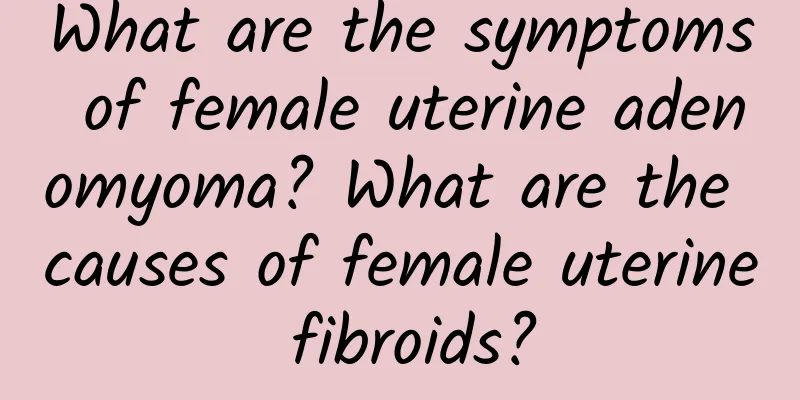What are the symptoms of female uterine adenomyoma? What are the causes of female uterine fibroids?

|
What are the symptoms of female uterine adenomyoma? What are the causes of female uterine fibroids? Uterine adenomyosis is a common gynecological disease that usually occurs in women of childbearing age. However, many patients know little about its symptoms and causes. This article will give you a detailed introduction to the symptoms and possible causes of female uterine adenomyosis, and list some common symptoms for your reference. 1. Symptoms of adenomyoma in women 1. Abnormal menstruation: One of the common symptoms of adenomyoma is abnormal menstruation. Patients may experience increased menstrual flow or shorter menstrual cycles. In some cases, patients may also experience prolonged menstruation, that is, menstruation lasting more than 7 days. 2. Abdominal pain and discomfort: Uterine adenomyosis can cause abdominal pain and discomfort. Patients may feel abdominal distension, bloating, or dull pain. The severity of the abdominal pain may vary depending on the size and location of the adenomyosis. 3. Pelvic compression symptoms: Large adenomyomas may compress surrounding tissues, leading to pelvic compression symptoms. Patients may experience symptoms such as frequent urination, urgency, constipation or diarrhea. 4. Infertility: Some female patients may experience infertility problems. Uterine adenomyosis can affect the implantation of fertilized eggs and in some cases may cause deformation of the uterine cavity, thereby increasing the risk of infertility. 5. Other symptoms: Some patients may also experience other symptoms, such as low back pain, feeling of heaviness in the lower abdomen, pain during sexual intercourse, etc. 2. Causes of uterine adenomyosis in women 1. Hormone imbalance: Hormone imbalance is a common cause of adenomyosis. The imbalance of estrogen and progesterone may lead to endometrial hyperplasia and muscle cell hyperplasia, forming fibroids. 2. Genetic factors: Genetic factors may also contribute to the occurrence of adenomyosis. Studies have shown that women with a family history of adenomyosis are more likely to develop the disease. 3. Other factors: Age, reproductive history and dietary habits are also related to the occurrence of adenomyosis. The older you are, the higher the risk. Women who have given birth to many children have a lower risk, while women who have no childbearing experience have a higher risk. High-fat and high-sugar dietary habits may also increase the risk. Uterine adenomyosis is a common gynecological disease in women, often accompanied by symptoms such as abnormal menstruation, abdominal pain and discomfort, pelvic compression symptoms, and infertility. Hormonal imbalance, genetic factors, and other factors such as age and reproductive history may all be causes of uterine adenomyosis. If women find the above symptoms, they should seek medical attention and receive necessary treatment in a timely manner. At the same time, regular physical examinations and maintaining a healthy lifestyle can also help prevent and reduce the occurrence of uterine adenomyosis. |
<<: What causes uterine fibroid pain? What to do if uterine fibroid pain
Recommend
Are your blood vessels always scratching? 3 powerful foods to activate blood vessels
Although he looks like a young man in his 30s, hi...
What to add to pigeon stew to treat uterine fibroids? Can pigeon soup treat uterine fibroids?
What can be added to pigeon stew to treat uterine...
What is the reason for menstruation after amenorrhea?
What happens when menstruation comes back after a...
What to do with ectopic pregnancy? 3 ways to treat it
Under normal circumstances, the fertilized egg im...
Women must take precautions against pelvic inflammatory disease
Pelvic inflammatory disease is a common gynecolog...
In what aspects of the female body do symptoms of vulvar leukoplakia appear?
Vulvar leukoplakia mainly affects women, with the...
What to do if adenomyosis causes bleeding after pregnancy
What about bleeding after pregnancy with adenomyo...
Endocrine disorders can easily induce uterine fibroids
Uterine fibroids are a type of tumor that depends...
Is it okay to take progesterone if menstruation has not come? Go to the hospital for a check-up first
Many women experience amenorrhea due to various r...
What to eat for irregular menstruation? Teach you seven dietary therapies to easily treat irregular menstruation
Menstruation has been a "good friend" o...
Exercise in the late stage of cervicitis
Exercise in the late stage of cervicitis. We know...
What to eat to restore ovarian function, 3 types of food are very suitable for women
Ovarian function is very important to women's...
Understand the early symptoms of cervicitis and prevent it early
What are the early symptoms of cervicitis? The ce...
What are the preventive measures for chronic cervicitis?
Chronic cervicitis is one of the common genital t...
Childhood Obesity Decoded! Genetic testing and symptomatic treatment
Obesity is not a disease, but it is the root of a...









